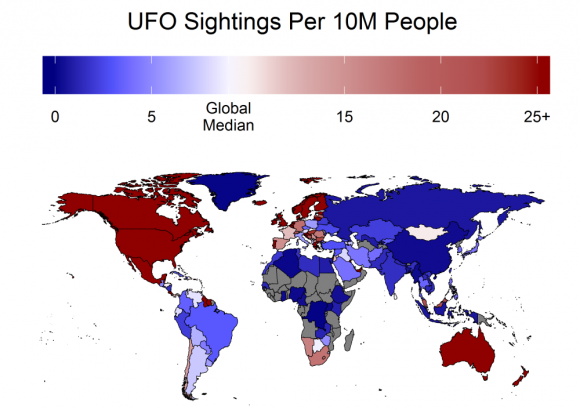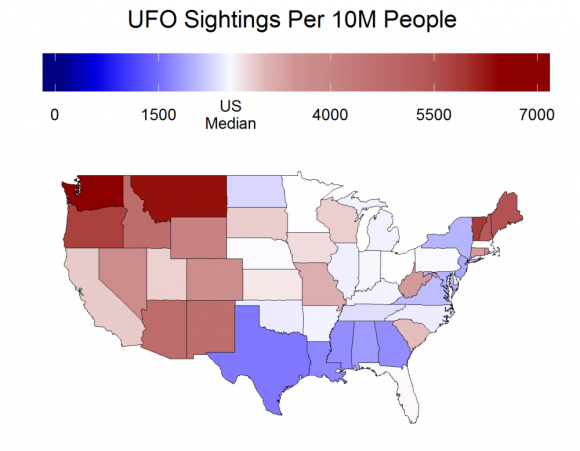When it comes to conspiracy theories and modern preoccupations, few things are more popular than unidentified flying objects (UFOs) and alien abductions. For over half a century, there have been rumors, reports, and urban legends about aliens coming to Earth, dabbling with our genetics, and conducting weird (and often invasive) experiments on our citizens.
And while opinions on what drives this popular phenomenon tend to differ (some say hysteria, others that it is media-driven), a few things are clear. For one, sightings appear to take place far more in the United States than anywhere else in the world. And in recent years, these sightings have been on the rise!
Such are the conclusions of a series of visualizations based on the National UFO Reporting Center (NUFORC). Established in 1974 (and located in Davenport, Washington), the National UFO Reporting Center is “dedicated to the collection and dissemination of objective UFO data”. Since that time, they have been monitoring UFO sightings worldwide and have maintained careful logs about the 104,947 sightings that have taken place since 1905.

Using this data, Sam Monfort – a Doctoral Candidate from the department of Human Factors & Applied Cognition at George Mason University – produced a series of visuals that illustrate the history of UFO sightings. And based on the visualized trends, some rather interesting conclusions can be drawn. The most obvious is that the geographical distribution of sightings is hardly even. For starters, reports in the USA were equal to about 2500 sightings per 10 million people.
This is almost 300 times higher than the global average. Based on individual states, the concentration of sightings was also quite interesting. Apparently, more sightings happen (per 10 million people) in the West and Northwest, with the highest numbers coming from Washington and Montana. Oregon, Idaho, Arizona and New Mexico also made strong showings, while the Great Lakes and Midwestern states were all consistent with the national median.
On the opposite coast, Maine, Vermont, and New Hampshire all had a good number of sightings per capita, though the state of New York even as New York was beneath the national median. Texas actually ranked the lowest, and was followed by the Southern states of Louisiana, Mississippi, Alabama and Georgia. But as Monfort told Universe Today via email, this may be slightly skewed because of who is collecting the information:
“[I]t’s worth mentioning that the NUFORC is an American agency (“N” stands for “National”). They make an effort to record international sightings (phone banks staffed 24/7), but I’d guess that sightings in the USA are still over-represented. Honestly, I’d bet that the NUFORC being based in Seattle is the main reason we see so many more sightings in the States. A more thorough analysis might cross-reference sightings from other agencies, like MUFON.”

Canadians did not do much better, coming at second place after the United States with 1000 sightings per 10 million people. And according to a recent article by Allan Maki of The Globe and Mail, its becoming more common – with a record 1982 sightings reported in 2012. He also suggests that this could be due to a combination of growing interest in the subject and reduced stigma.
Iceland, the UK, Australia, the Virgin Islands and Cyprus all ranked a distant third, with between 250 and 500 sightings per 100 million people per year. New Zealand, Mexico, Israel and the Gulf States also produced considerable returns, as did the United Kingdom, Ireland, Portugal, Belgium, Danemark, Finland, Sweden and Norway.
From this distribution, one might make the generalization that more developed nations are more likely to report UFOs (i.e. better record-keeping and all that). And this is a possibility which Monfort explored. In another visualization, he cross-referenced the number of sightings in a respective country with amount of internet access it has (per 100 people), and a limited correlation was shown.
Nations like Israel and the Gulf States have a higher number of sightings than neighboring countries like Syria, Saudi Arabia and Iraq, while South Africa has more reported sightings than several North African and Sub-Saharan African nations surveyed. However, fast-developing nations like Russia, China and India showed a lower than average level of sightings, while Guyana and Suriname showed a higher than average level.

France, Italy and the Czech Republic also lagged behind many of their European counterparts, and Germany and Spain were only slightly higher than the average. So much like distribution by state within the US, internet access does not seem to be a consistent determining factor. Another interesting visualization was the one which broke down the sightings per decade based on the nature of the sighting.
As you can see from the table above, when UFO sightings first began in the early 20th century, they reportedly took the form of either a sphere or a cigar-shaped object. This differs from the 1920s, when “flying saucers” began to appear, and remained the dominant trend throughout World War II and the Cold War era. And ever since the 1990s – what Monfort refers to as “post-internet” era – the most common UFO sightings took the form of bright lights.
“If I had to guess, I’d say it was a combination of factors,” said Monfort. “Like I mentioned in the blog, it seems a lot more plausible that someone would see strange lights in the sky than a flying object with a concrete shape (like a saucer). Seeing a shape implies that the object is pretty close to you, “and if it’s that close why didn’t you take a video of it?”
As for other factors, Monfort considers the possibility of fireworks and (as one comment on his blog suggested) Chinese lanterns. “Those are the little paper balloons you light a candle in and let fly. Some of the bright light sightings could be those, especially since I’d bet most Chinese lanterns are released in groups, with several people going out in groups to release them together. (Often people report formations of lights.)”
Further Reading: Visualize This


would love to believe that there are aliens out there somewhere, and all the sightings, but why no contact?
Is there any possibility that the aliens are in another dimension , that they cannot contact us or if they see us the run because there not sure what we are? There have been sightings for many years there are satellites constantly looking for them and listening for them, if they are there or there is any possibly that they exist, then why no contact. I cannot believe that there is any cover up not for this long and someone would have leaked it they leak bigger problems than that.
Does anybody have any idea if they exist or there is any information or proof that something is out there. Please someone give me something that gives me hope and not just another sighting or another important person that is credible .
I would surmise that contact has been made, as early as the 1930’s; effectively around the time when humans began dabbling in nuclear technology. But that’s something I;m not going to talk about, now. Instead, lets talk about South Park!
I like how South Park portrayed aliens. In the episode, Stan’s dad, Randy, helps Stan build a box car derby racer and adds a super conductor magnet, from the LHC – this makes Stans’ box derby car, illegal and super fast. Fast enough to break the speed of light.
Once the word breaks that planet earth civilization has obtained the technology to supersede the speed of light – the Galactic Federation takes notice and plans to present a test of good will to the civilization of earth.
The galactic alien alliance visits planet earth, under the guise of one, bandit alien, on the run form the galaxy police for stealing federation money. A false pretense of first contact designed to test mankind’s’ readiness to join the galactic federation. The citizens of south park, unsure of what to make out of this “first contact” being associated with an alien thief, decide to kill the alien and steal his “galaxy money”. The citizens then begin contacting world leaders to discuss the event and split the “galactic money”.
At this point, the Galactic Federation pays an “official” visit to planet earth, under the guise of Galactic Police chasing the thief, that had recently landed on Earth. The south park citizens claim that they’ve seen no sign of this alien-thief, nor the money the thief had stolen. The Galactic Police are shocked at how unfazed the earthlings are their presence, considering it should be the “first contact” – if the thief never show his face.
South Park and world leaders are spending galactic cash in humorous ways, like when the Galactic Federation notices that 100 water parks have been built in Mexico in the span of two weeks. Sweden confesses to the World Leaders that they should all come clean to the Galactic Police; The other world leaders agree to nuke sweden.
At the end of the episode, the Galactic Police come clean: We are not police we are representatives of the federation assessing this planets ability to be a part of the federation. The officials inform the citizens of earth that the “thief” was in fact a plant and that the “cash” was worthless. The entire event was a test to see if Earth was worthy of joining the intergalactic community but humans proven to be too selfish, greedy, chaotic and deceitful. As punishment for failing, the Earth and the Moon are isolated from the rest of the Universe, by way of some alien space / time cage.
Interesting. A UFO is a UFO until is it identified. There may be many things starting from meteors / satellitels / ISS / Iridum Flares/ Airplanes / Drones/ Weather or Helium balloons and many many mores.
The solution is obvious. We will build a Great, Beautiful, Exciting, Gleaming Huge geodesic dome that will be designed by the great up and comer American architect Buckminster Fuller (I hear he’s working on a scaled down model in Montreal) and I assure you we will make the aliens pay, believe me
Overall solid article, with minimal amounts of sarcasm, which I’ve come to expect on Universe Today when UFOs are covered. Two quick points:
“From this distribution, one might make the generalization that more developed nations are more likely to report UFOs (i.e. better record-keeping and all that).”
1. Saying “record-keeping and all that” is not only a tad sarcastic, but also scientifically lazy. These developed nations are testing higher technology; perhaps other advanced civilizations have far greater interest in scientifically-advanced areas of a planet than those less so.
UFO reports around the United States skyrocketed in the 1940’s; incidentally, this is also when nuclear weapons began being tested. Perhaps this is not a coincidence.
2. Considering the sheer volume of UFO reports not only in the United States, but around the world, simply dismissing these as “hallucinations” or “mass hysteria” is not a proper application of the scientific method.
If the planet earth is vital to the health of the solar system and the sol systems is vital to the galaxy and the galaxy is vital to the universe, and if humans are not the most advanced species in the the universe, then it would surprise no one if aliens came to earth in search of world leaders to quell the proliferation of nuclear weapons, and possibly offer an ultimatum regarding the use of nuclear weapons. IF nuclear weapons have the ability to destroy the planet, which could possibly send the sol system into chaos, and in turn, the galaxy and — nevermnnd this planet aint that special, not special enough to be connected to the well being of the universe.
At no point did we dismiss anything here. In fact, we take no position on the validity of sightings or what they mean. However, saying that the volume of UFO reports means that they must be some validity is not scientific in any way. Popularity or commonality is not the same as fact.
As for assuming that reports of UFOs are higher in developed nations is because aliens would be interested in advanced nations, that too is unscientific. More than that, its wildly speculative. It assumes UFOs are in fact aliens and reports of sightings are entirely valid.
With all these sittings and just about every human on Earth having a cell phone why hasn’t there been a photo of just one UFO? I just don’t understand this. Maybe they don’t want there photo taking. wc
Too far away and a hell of a long time ago.. maybe an advanced ETI came up with a way to _transmit_ at the speed of light, self-assembling DNA sequences to candidate stars? And Thou art that?
Interesting…..what I wonder is can every single one of these reports be without merit.? If only one represents a real sighting of alien life forms then that is enough. Pretty cool.